CONTENTS:
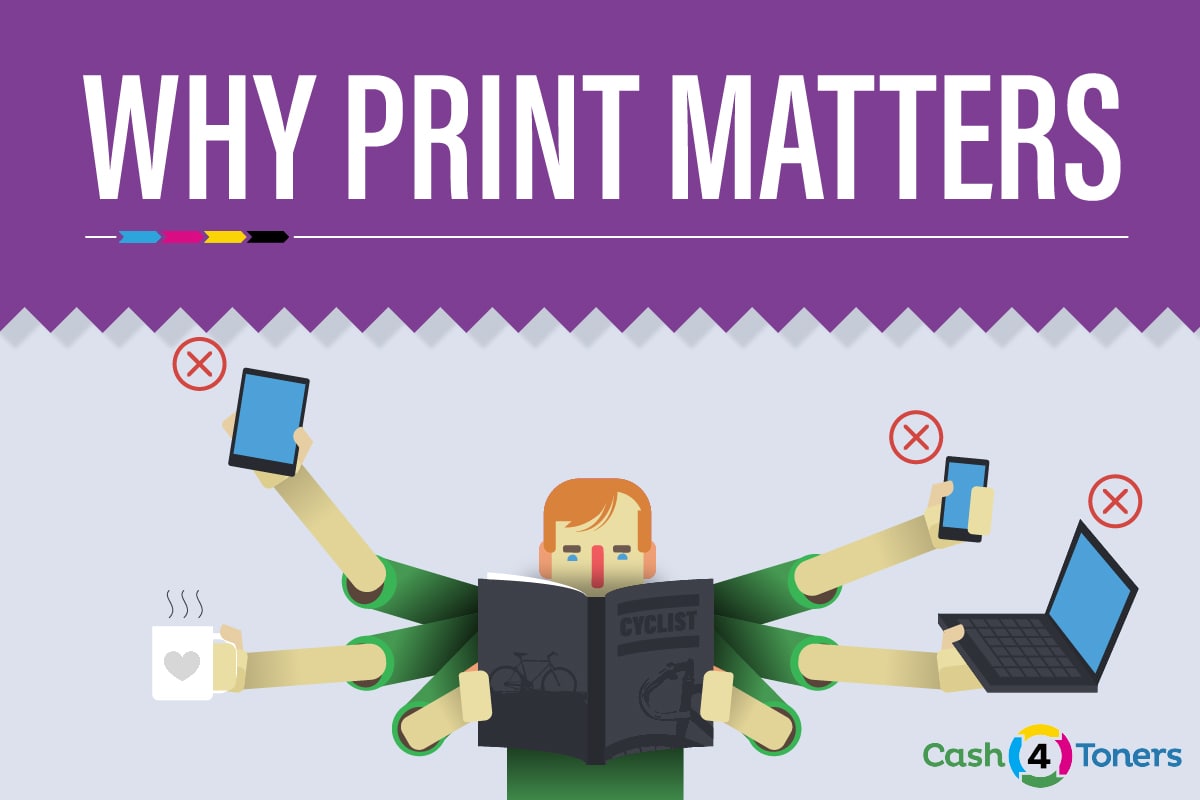
CONTENTS:
Does print matter? Is print advertising dead? Do people still read magazines?
In today’s digital world it’s easy to assume print advertising is dead.
But print matters! Print advertising is still alive and working!
The above assumption may have a grain of truth, but saying print advertising is completely dead is an exaggeration.
We still see ads in magazines and newspapers, don’t we?
Well, that means print advertising is still alive and it still works.
Paper ads are not dead. Print matters.
Printed media is not dead and staying afloat despite all the negative predictions and skepticism around it.
Even more, in some industries, it remains the number one marketing platform.
Surprised?
We at Cash4Toners decided to dive a little deeper and see how research and data back up these bold statements! Print matters!
What Is Print Media?
Print media is a general term for any words or text that appear in printed form on paper or some other medium.
This includes everything from newspapers, to billboards, to the advertisements plastered on the sides of buses.
Books, magazines, and newspapers were the original mass-market format for printed media, and they continue to rank high for reader trust.
While you “can’t believe everything you read” — even in print media — there are several good reasons readers trust the print medium.
Is print media dying? Not at all. While digital media is cheaper and easier to produce and distribute, print media still holds a special place in the hearts of consumers.
Printed media has been carefully vetted to reduce errors and ensure the message is clear. This is why readers trust printed media more than digital media.
It’s been crafted with readers in mind.
Print Vs Digital Advertising: Print Matters When It Comes to Emotions and Feelings
Nothing’s as good as it used to be … even surfing the Internet.
Once upon a time, when the Internet was still a relatively new thing, the World Wide Web could trigger strong emotions.
Everything related to the Internet, all those experiences associated with it, felt novel and new.
Today, the Internet is an integral part of everyday life, a regular routine.
For some, surfing the Internet is even part of their job. That means it can get boring.
So, as the Internet loses its “freshness,” the level of feelings and emotions it transmits is also limited.
Generally, we sense the digital world with our eyes, meaning that only one out of five main human senses is in play here.
Digital is not possible to touch and smell … yet.
This is where print matters.
Journals, magazines, catalogs, newspapers – all print ad carriers are tangible and experiential.
Generally, the human and print interaction is predominantly based on tactile contact (except for print ads that we see from the distance, like banners).
Print ads are real, and consumers can physically interact with them. This adds two more human senses to the list: touch and smell.
All these play a huge role in how ads work and what results they deliver.
U.S. Postal Service worked with Temple University’s Center for Neural Decision Making to conduct a neuromarketing study to find the difference in human response to physical/digital media.
The study also looked at how human senses affect consumer buying and purchase intent.
Note: Neuromarketing is a scientific method that helps to explore the respondent’s subconscious response as opposed to conscious answers to survey questions. This method helps to understand the actual activity deep in the brain which leads to more reliable data.
A Stronger Emotional Response
The study clearly showed that physical ads led to a stronger emotional response, and participants remembered them better.
Participants also spent more time on physical ads compared to digital ones. Print matters, people, especially when it comes to advertising!
The table below shows all study attributes and test outcomes for each media platform.
X shows which media performed better.
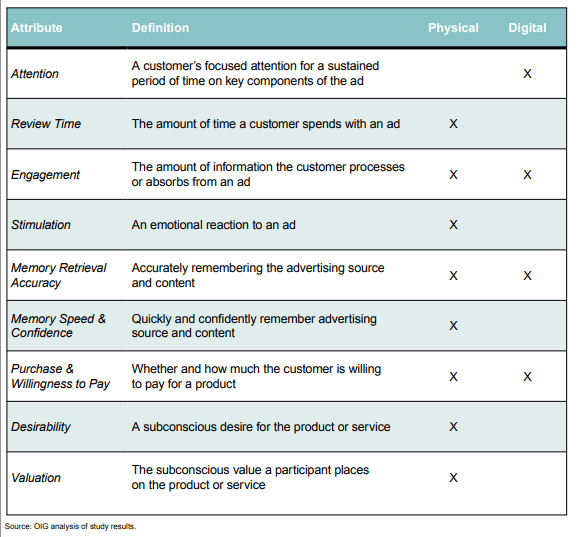
As can be clearly seen, digital advertising lacks some important sensory and emotional factors that print offers.
Print simply establishes more emotional and natural contact with the reader.
Unlike digital ads, consumers can physically browse through a print newspaper or magazine (and different types of print ads contained in them), grip the pages, feel the paper texture, density, and composition. Print matters to consumers.
More sense means more channels for ads to transmit the message into the consumer’s conscious and/or subconscious mind.
In today’s omnichannel marketing environment, these factors cannot be ignored.
For the true omnichannel experience, print is essential.
Why Print Matters: Consumers Trust Print Ads and Other Traditional Advertising Channels More
Print ads got the first spot with an impressive 82% in a survey conducted by Marketing Sherpa on customer trust:
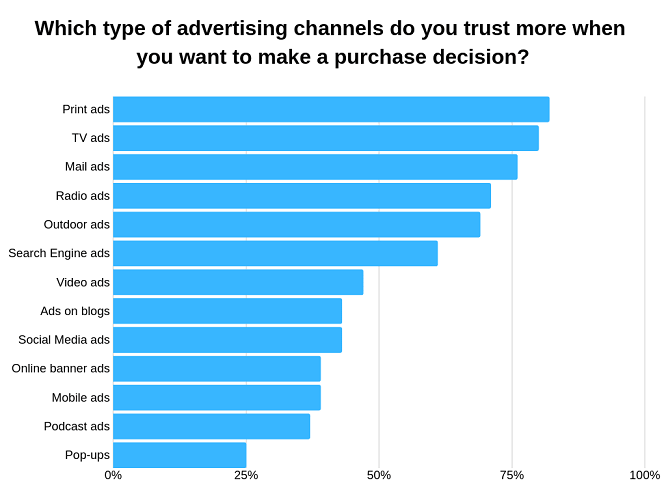
So, compared to digital, print advertisements have an imperative and unique value: people really care about them, people trust them, and people are actually paying attention to them.
Today, consumer trust is one of the most scarce and precious components of the whole advertising realm.
Although most of us probably expected digital to easily win this top spot, the study shows the opposite.
Traditional advertising outlets, including print, still hold the top five spots when it comes to customer trust. Printer matters…still.
And this is another critical aspect not to be ignored by marketers in today’s digital-centric world.
Print is Not Dead: Statistics
Below you will find additional statistics that once again demonstrate that it’s too early to write off print.
Let’s see what the numbers say…
Shocking Response Rates
- Response rates for direct mail have been on the rise during recent years. Catalog/direct mail combination saw customer response rate increase by a whopping 43% YoY, and even more than doubling prospect response rate reaching a shocking 190% increase in 2016. Direct mail response rates were 5.3% (43% increase YoY from 3.7% in 2015) for house file and 2.9% (more than doubled YoY) for prospect list. In 2018 both these numbers reached all-time highest figures: response rate for prospects list reached 4.9% which is the highest number during the last two decades and response rate for house lists was at an impressive 9%.
- Generally, direct mail provides the best response rates among all direct marketing mediums:
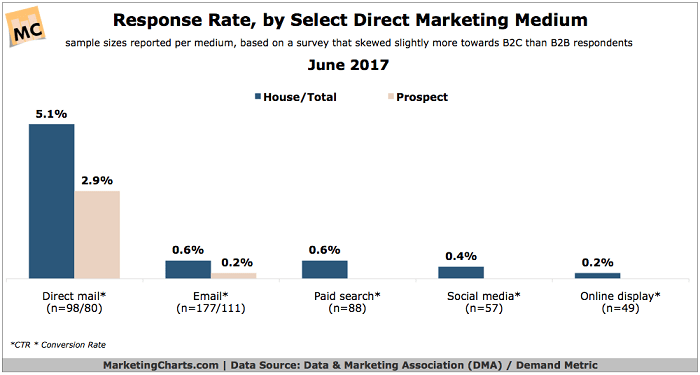
- Oversized envelopes have household response rate of 6.6%, followed by postcards (5.7%) and letter-sized envelopes (4.3%).
- Proper 1:1 personalization boosts response rates by 50%.
- 2016 was a particularly successful year for print marketing with postcard reads also increasing 3.9% YoY.
- However, despite being a great year for print marketing 2016 saw the overall volume of direct mail decreasing to 149.40 billion.
- The total volume of mail received by US households in 2017 was 121.2 billion.
- Half of US consumers prefer direct mail over email.
- The average household gets only 2 pieces of direct mail a day compared to 157 emails.
Engagement Party
- On average consumers spend around 30 minutes reading their mail (45 minutes on magazines; 30 minutes on catalogs; and 25 minutes on direct mail).
- 79% of consumers find reading physical mail more convenient than reading emails.
- Thus, 73 percent of Americans and 67 percent of Canadians prefer physical mail for brand communications specifically because they can read it at their convenience.
- At the same time, 51 percent of Americans and 49 percent of Canadians pay more attention to direct mail than email.
- It has been scientifically proven that reading on paper requires impressively less cognitive efforts compared to digital. Thus, the human brain needs 21% less cognitive resource to process the information on print. This helps readers to easier grasp the information and remember it longer.
- In fact, consumers remember the brand name 70% better if they see it on a print ad (75%) compared to digital ad (44%):
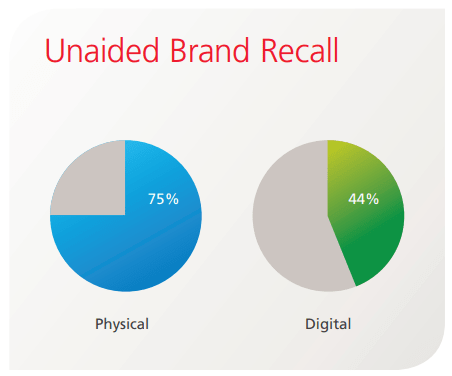
- It is believed the human brain processes visuals 60,000 times faster than text, which makes print visuals even more powerful.
- 39% of customers first try a business because of print advertising.
- 25 billion coupons were redeemed in 2015.
Effective Impressions
- 10% more customers will visit advertiser’s website because of effective print ads.
- 26% of them will keep direct mail for future reference.
- 25% of them actually spend more when businesses reach them through both direct mail and email.
- 62% of US consumers and 63% of Canadian consumers admitted that they actually enjoy checking their mail.
- 40% of all American adults look forward to checking their mail.
- 56% say that receiving a mail is a “real pleasure” for them.
- 55% look forward to finding out what mail they received.
- 70% feel that direct mail is more personal compared to digital.
- 70-80% of them open almost all of their mail.
- Direct mail is 20% more likely to motivate consumers to take action compared to digital media.
- Accordingly 79% of consumers immediately act on the mail they receive with direct mail response rates reaching 24% (14% increase over the last 10 years).
- And generally, direct mail open rate is between 80-90% compared to 20-30% email open rates.
- Overall, direct mail outperforms digital marketing channels by around 600%.
- Direct mail boosts ROI by 20% when it is included in an integrated campaign. With digital ads direct mail brings in 28% better conversion rate.
- 88% of millennials believe print is more official than digital.
- 88% of magazine readers in the UK preferred print.
- 90% of them consider print reliable.
- 75% find it valuable.
- And 87% of them like receiving direct mail.
- Financial services followed by packaged goods are the most active direct mail users.
Marketing Potential
It goes without saying that all those numbers and facts add up to tremendous marketing potential.
Traditional advertising channels are experiencing a renaissance.
Some accomplish this by adapting to digital environments and/or transforming into a new digital format.
Internet radio and podcasts are great examples of this trend.
It’s pretty obvious that podcasts, in their essence, aren’t much different than radio, other than being purely digital.
Moreover, the listenership of both channels (online radio and podcasts) have been on a steady rise.
In fact, the percentage of podcast listeners doubled between 2008 and 2015 in the US (from 9% to 17%). Now 44% of American adults listen to podcasts (at least 35% do so while in the car) and 53% of them listen to online radio (73% on a smartphone, 61% on desktop and laptops).
Importantly, the trend is continuing. The listenership of traditional radio (AM/FM) is not going anywhere.
About 91% of Americans listen to AM/FM radio at least on a weekly basis.
Printer Matters, Offering An Uninterrupted and Undivided Experience Compared to Digital Noise
Reading something online can easily turn into a real challenge with all those pop-ups, flashing ads and banners, auto-play videos and notifications appearing just next to what you read or, even worse, on top of it.
Although it is actually easier to get the reader’s attention with a digital ad than with a print ad (as we can see from the US Postal Service and Temple University’s Center for Neural Decision Making collaborated research above), it is harder to hold it.
Digital ads are easily forgotten. Reader’s attention on the Internet is almost always the subject of competition.
This naturally leads to distractions, distorted focus, and fatigue which affects any digital ad performance. Digital ads are more annoying than effective!
For example, look at these digital ads stats from HubSpot:
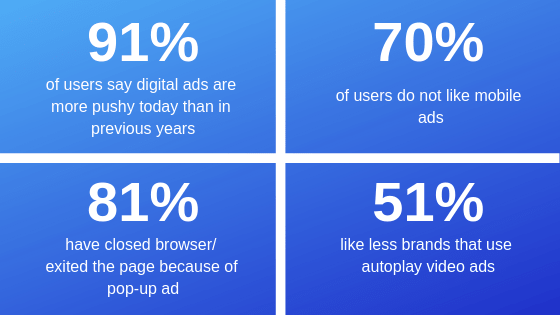
By contrast, this can’t happen with print.
The print experience is much more relaxed and focused.
There isn’t a constant flow of other media vying for your attention, distracting you when you read a printed magazine or newspaper.
Reading on print can even help reduce stress.
How?
See below:
Reading reduces stress
A study by Mindlab International at the University of Sussex in England found that reading can reduce stress levels by 68%.
Even a mere six minutes of reading a book can reduce your stress levels by more than 2/3, according to the University of Sussex report.
Subjects in the study were run through a range of tests and exercises to increase their heart rates and were then tested with a variety of relaxation methods.
The study found that reading worked best for lowering stress levels, followed closely by music which can reduce stress levels by 61%.
A cup of tea or coffee can lower your stress by more than 54% and taking a walk by 42%.
According to researchers, losing yourself in any grossing book is the best form of relaxation.
Moreover, when reading magazines and newspapers, the reader is not intentionally searching for specific information which is almost always the case with digital.
The information flows more organically. Print matters when it comes to conveying important information and print does it faster.
The most common experimental findings suggest that reading from a screen is 20% to 30% slower when compared to reading from paper.
Let’s Get Complicated
Unsurprisingly, complicated information that requires stronger concentration is also better followed in print than in digital.
Concentration needs to stay uninterrupted for a certain period of time for complex information to sink into the reader’s mind.
Print media simply provides better conditions for this to happen compared to digital media.
Print allows an uninterrupted reading experience, meaning there is a greater chance your target audience will read all of your material — all the way to last sentence — without interruption.
So far, there are no pop-ups and push notifications (or any similar alternative) invented for print media.
It is also less common to multitask when reading magazines and journals.
People reading printed information are usually just doing that, and this is far from true when it comes to reading online.
We massively multitask when we are online, which makes this experience hectic … even chaotic.
As a result, our attention is divided during an online experience. You’re fighting for the reader’s attention, competing with all the distractions on the Internet.
With print, by contrast, the reader’s attention is much likely to be 100% yours.
There Are No Ad-Blockers in Print and Readers Conceive Ads as an Integral Part of Their Purchase
As digital ads get more annoying, ad blockers, meanwhile, are quickly gaining popularity among Internet users.
Ad blocker usage is currently on the rise. According to Statista, 25.2% of all US web surfers used ad blockers in 2018. This number is expected to reach 27.5% by 2020.
Ad blocking user penetration rate (US) 2014-2020
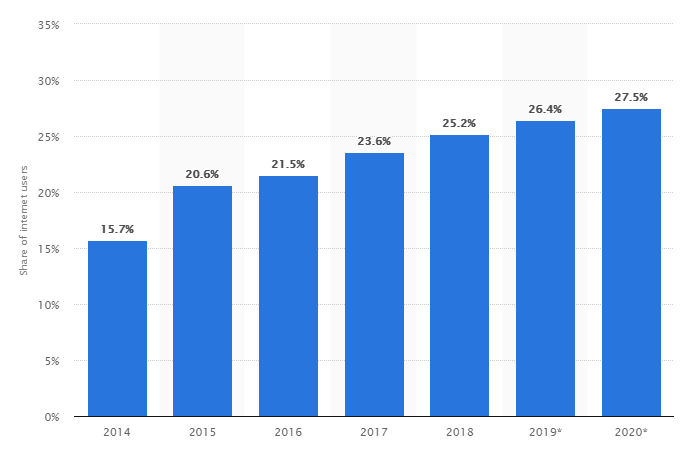
And this is likely to be a global trend
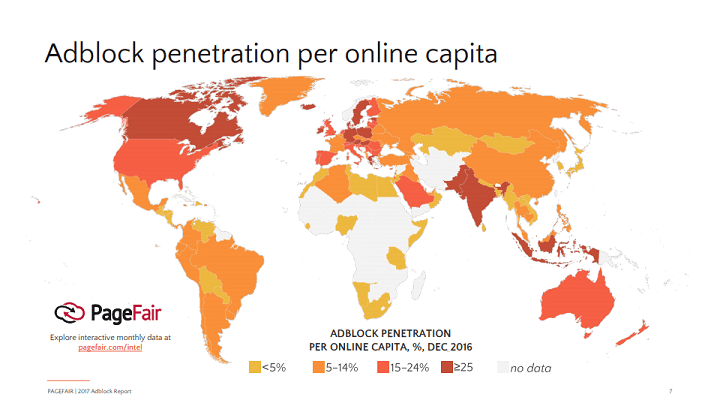
There are two fundamental differences when it comes to print ads vs. digital.
First, consumers perceive print ads in a totally different way compared to digital ads.
Print ads are an absolutely essential part of the whole sales experience.
Readers pay for the entire print experience as a whole, and ads are part of this experience.
This is not the case with digital media, where ads are perceived as an inorganic or intrusive part of the user experience.
Second, there is no ad blocking for print! You don’t have to worry about your ads not getting seen with print!
It’s technically impossible … simple as that. Yet another example of how print maters.
Print Matters: Print Ads Last Longer with No Ongoing Budget Required
Ads in today’s digital world don’t live long. They only last as long as there is a budget left to fuel their presence.
Once the advertising budget runs dry, digital ads stop working for you.
They simply cease to exist on the Internet (until you fuel them again with an additional budget).
Print ads, by contrast, offer a much longer lifespan. They last until the paper they’re printed on crumbles. And they require no additional budget.
It’s true that print advertisements take time to get published and reach the user.
Measuring the effect of print advertising takes even longer. It’s not trackable, like click-thrus, or digital PPC.
However, once a print ad is live, it is hard to predict for how long it will be around.
Your print ads might continue to live — on tables and desks, in hotels, cafes, offices and waiting rooms — literally for years.
And, during all this time, the ad you paid for only once continues working for you.
The number of impressions will keep rolling in during the entire lifespan of your physical ad.
In this aspect, print ads are drastically better than digital ads. This is an often overlooked marketing advantage.
Smart marketers seeking a long-lasting, omnichannel experience in 2020 and beyond should consider print.
For the foreseeable future, digital ads are unlikely to deliver a comparable opportunity. Print matters.
Print Matters In Some Industries and Segments, Providing Completely Unique Advantages
In certain industries — like travel, hospitality, and luxury — print looks like a better advertising platform compared to digital.
With full-page visuals, paper choice, and other available tools, marketers in these industries can create a better ad experience.
This helps advertisers effectively pass the right message to consumers.
This, while certainly possible, is harder (and perhaps less effective) online. Users access web pages from different devices.
Not all those devices have the same level of screen quality, resolution, and size.
The effect of a full-page, high-resolution, visually appealing ad might be totally different on different devices (old/new desktop, smartphone, tablet etc.).
For example, currently more than 39 out of 50 news sites are actually accessed by users from mobile and not from the desktop.
There are too many parts involved to guarantee consistent ad performance on all device types.
You can’t even compare a full-page, full-color magazine ad to a mobile phone web page!
These two formats are not comparable in terms of impact potential and visual effect.
Purely Practical Purchases
However, it is also true that print media is probably less important for purely practical purchases.
For example, print is unlikely to compete with digital for office supply ads or purchases where brand/visual parts are less important.
In those markets print often looks more like a supplement to digital and not like the primary advertising channel.
Print is also not the best option for time-sensitive offers. It takes time for ads to reach users and provoke the necessary action.
On the other hand, print works better for products and services with longer consideration times (such as cars and travel packages).
There are specific market segments that print reaches and digital does not.
For instance, 41% of all Americans aged over 65 are not Internet users. They do not go online at all.
These people are simply not possible to reach with digital ads. Print advertisements, by contrast, reach all demographics with the same ease.
However, it is important to note that all age groups are interested in receiving and responding to direct mail.
Even more, in 2016 print marketing response rate doubled for the 18-21 age group.
Print Matters: What about catalogs? Do they still exist?
You might be surprised, but catalogs not only exist, they still work. Did we mention print matters?
Particularly in the multi- and omnichannel world.
Smart marketers know that customers who interact with businesses through multiple channels are the most valuable customers.
And catalogs are another underrated and perhaps a little forgotten channel to do just that.
However, it is true that catalog’s peak is certainly over and fewer catalogs are now printed every year.
The maximum number of catalogs was in 2007 – 19.6 billion. Since that time this number keeps going down:
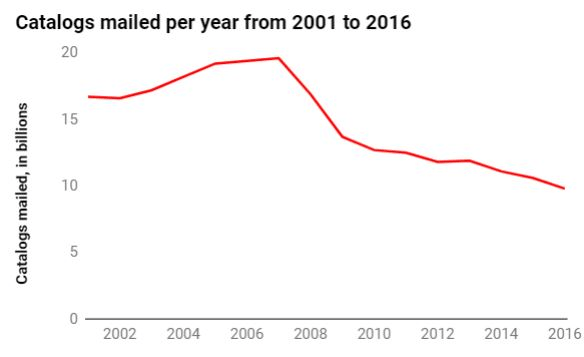
Nevertheless, it is important to keep in mind that this downward trend does not mean catalogs are completely gone.
There are still around 10 billion catalogs sent every year, and retailers allocate about $9 billion each year on print catalog marketing.
In short, print catalogs are pretty much still there. The numbers also indicate that catalog marketing is becoming less crowded.
There is more room for catalog marketing in the digital age.
The fact that the world became digitized does not automatically mean consumers stopped enjoying catalogs or other print marketing materials.
In practical terms, customers who have an omnichannel relationship with the brand (including print) spend four times more than those who do not.
A print catalog certainly plays an important role here.
Catalog stats in the digital era
- Not so long ago, in 2016 more than 100.7 million people in the US made catalog purchases (10.6 billion catalogs being mailed in 2015 and 9.8 billion in 2016).
- In the same year, catalog mailings went down for 4.5 percent, but overall response rates went up for 23 percent.
- 46% of consumers read catalogs they receive in mail (4% increase YoY from 42% in 2016) and 25% of them at least scan them.
- Catalogs still drive around 30% of consumers to shop online. 38% of them are millennials and Generation X.
- Roughly 58% of online shoppers browse print catalogs to look for ideas.
- One-third (31%) of them have a catalog nearby while making purchases online.
- 45% of consumers say that print catalogs stimulate their interest in a retailer’s products.
- The average spend of Internet-only shopper is usually around $80 per order. In contrast, shoppers who search a catalog before buying (including online) on average spend about $90 per order.
- Average online order is usually 6% lower compared to orders placed through a direct mail catalog.
- Around 86% of women (18-30 age group) make a purchase online after first seeing the item in a catalog.
So, surprisingly, print catalogs still carry serious marketing power in the Internet-centered world of today.
It is worth noting that some companies experimented with getting away from catalogs.
It did not turn out well. Lands’ End tried to cut back on catalogs in 2000, which led to a $100 million decline in sales.
After conducting an online survey and finding 75% of customers saw the item in the catalog before placing an order online, catalog marketing made a comeback at Lands’ End.
Future of Print Media: Print Is Here to Stay
So, is print media dying? Does print matter?
No, print is definitely not dead and not dying.
Yes, there is some data that shows the overall win of digital over print.
For instance, print circulations, after some fluctuations, are finally going down. (In 2014, weekday circulation of top tier newspapers fell by 4% after a 22% spike between 2012 and 2013.)
Total circulation of US daily newspapers:
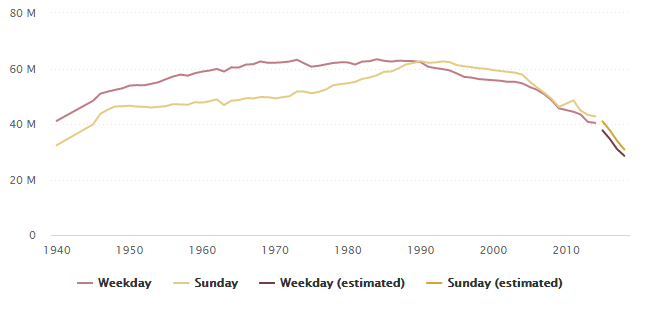
And so are newspaper ad and circulation revenues:
Total revenue of newspapers in the US:
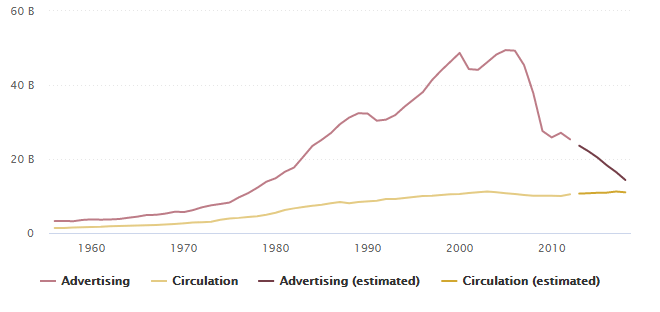
It is also true that newspaper advertising revenue shifts towards digital with each coming year. (There was a huge 4% increase between 2015 and 2016.)
Newspaper ad revenue coming from digital ads:
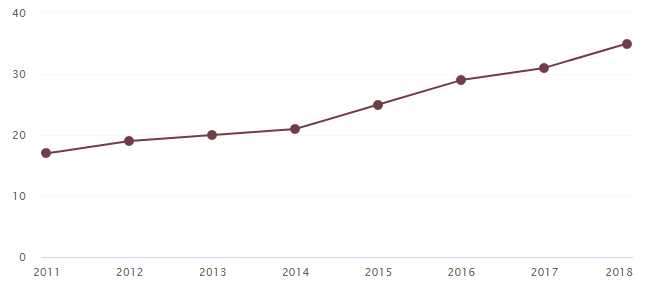
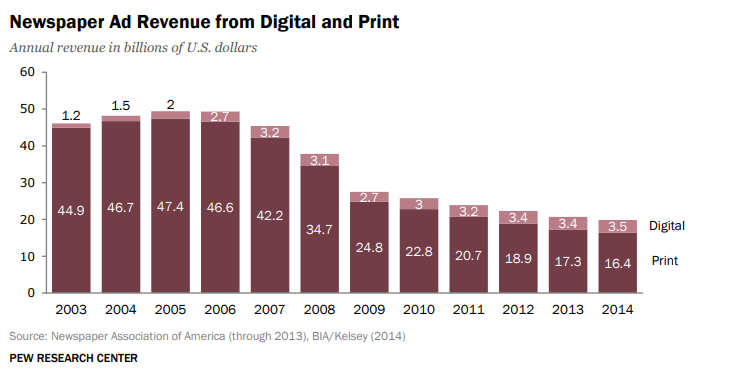
Note: Between 2005 (this was actually the peak ad revenues year for US newspapers with $49.4 billion in ad revenue) and 2014 US newspapers revenue sources changed from $47.4 billion in print/$2 billion in digital to $16.4 billion in print (that’s about 66% drop)/$3.5 billion in digital.
Jobs also seem to be shifting from print to digital, with 30 major and 438 smaller digital news organizations creating around 5,000 full time jobs.
Getting Engagement
But, in most of the cases, this overall decline in print circulation also means the readership has been narrowed down to the most engaged readers.
Thus, 56% of people who read newspapers, read them in print. Only 11% read newspapers on a computer and only 5% on a smartphone.
Print matters when you’re trying to reach consumers.
Circulation magazines (despite the downward trend) are also still around (and are quite popular). The audience they reach is usually the most interested and loyal.
This is a valuable factor from the advertising and targeting point of view (including local print advertising).
Accordingly, print readers today are naturally much more inclined to convert to your message.
This actually turns out to be one of the primary advantages print media provides.
Today, print advertisements can be targeted to clear-cut audiences with specific interests and passions.
Print also has a strong ROI index (direct indicator of print advertising effectiveness).
According to AMA, GfK Panel Service (Germany-based research firm specializing in ROI) performed research and found out that magazines and newspapers deliver the highest ROI (125%).
Far more (+38%) than other ad mediums such as TV and Digital (87%).
Spending Smarter
More than that, print Return On Advertising Spend (ROAS) is the best among all media:
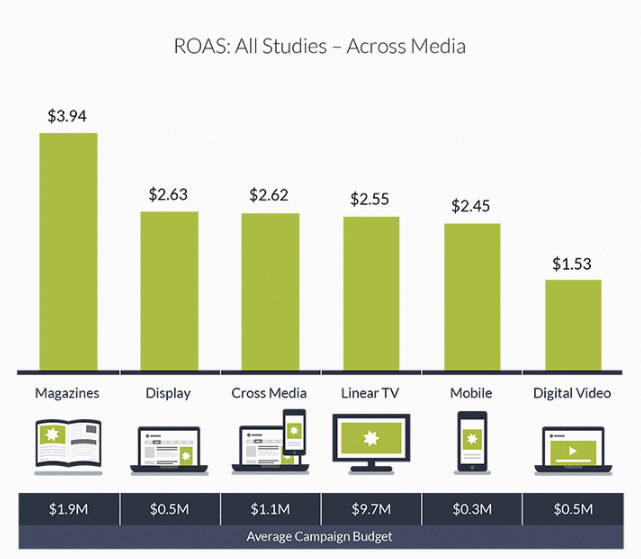
As the facts, trends, and data show, print isn’t dead and print ads are here to stay.
Print media remains one of the most important and powerful mediums to reach audiences and perform marketing activities.
Moreover, being a top-of-funnel medium, the print media is pure brand advertising.
This is an extremely important for boosting brand visibility and brand awareness (as it traditionally has been) as well as establishing brand worthiness and value in the market.
So, do not remove print ads from your advertising budget yet. Print is still there and print matters.
Instead, try to unleash its hidden potential and leverage print media for the benefit of your business.

Sources
2018 Infinite Dial Study by Edison Research and Triton Digital
Criteo Global Commerce Review US, Q1 2018
Pew Research, April, 2015, “State of the News Media 2015”
comScore Media Metrix, January 2015, U.S.
NewsBeat August 2016 (Published by the New York Press Association on behalf of New York’s Community Newspapers)
A Marketer’s How-To (and Why-To) Guide to Using Direct Mail, USPS
The Little Book of Bigger Returns (Royal Mail Group Ltd)
Quick Facts about Newspaper Media, News Media Alliance
From letterbox to inbox: building customer relationships 2013 (Published by The Direct Marketing Association, UK)
Dillon, A. (1992) Reading from paper versus screens: a critical review of the empirical literature. Ergonomics, 35(10), 1297-1326.
web.archive.org/web/20190930204652/https://www.telegraph.co.uk/news/health/news/5070874/Reading-can-help-reduce-stress.html
HBR
Kurt Salmon
DMA
USPS
Canada Post
Deloitte
Epsilon
Direct Mailing Center
Pew Research Center
3M Science
Stephanie
It’s so interesting. I would not have guessed that print is still more effective, but it makes complete sense when reading your points about the senses and how each are used. I’ll have to share this with my husband because he does graphics design and marketing for both print and digital.
Leona Martin
It really is great to see that print media advertising is still doing well. Gosh I remember those days of people saying paper will stop being used and then print media – nope to both. 82% of people trust print ads…..totally amazing – I honestly thought that number would be lower in this day and age. BTW I, too, love checking my mail.
Lauren
There’s nothing like reading a book or magazine the old fashioned way….as a hard copy! Even though we live in a digital age now, I agree that printing is still important and some people like me still value it!
Angela Tolsma
I not understand the advertising channels for making a decision. I am definitely a read reviews online type of person and recycle all print ads without looking at them. I am curious how those numbers will change over the years. I have never really thought about print ads. I am a huge fan of books, in physical form and getting pictures printed. I think both are important.
Kate
I totally agree! I am a big reader of print magazines and definitely engage more with ads I see when flicking through their pages than those that pop-up when I’m online – they are much easier to ignore.
David Elliott
Everybody does react differently. I never thought about the fact that once the Internet became ubiquitous that it wouldn’t have the same emotional impact.
Courtney
I prefer print over anything digital!!! I read so much more and for wayyy longer when I have an actual book/paper/magazine in my hand
Flossie McCowald
Fascinating data and infographic. The stats you crunch certainly make a persuasive case.
Amanda
I’ve always loved print more than online for some applications. I’m surprised to read that physical ads are more effective. Very interesting.
Christa
I love that info graphic! I’m (still) a fab of print. Not sure if it’s my age, but I’m distrustful of what I see online.
Neely Moldovan
Really interesting information and graphic! I learned so much!
Purva
Coming from print media, I am happy to read this article. The statistics are interesting. It’s sad to see so many magazines shutting down though. Hope they see a revival and continue to thrive.
Karen Monica
I totally agree. I have always love prints more than online. I find it more interesting and enjoying to read what’s printed compared to the digital version.
Fran Jorgensen
After trying to go paperless for a long time at home, I have just discovered that I just love paper and paperback books and magazines, I just love to sit down and scroll through the mag without holding a device or being chained to a computer.
Lynda Peter
As someone working in print media, I couldn’t agree less with you. The negativity on the internet is all one of the reasons print media will stay for a long time
Kirsten
I agree with many of the statistics outlined in this post. There is something about print media that is comforting and familiar. I know that for myself, I retain much more information when I’m reading a printed page versus a digital page.
Melanie Williams
Wow so much information in this article, you have packed this out with facts and stats for sure. Sometimes it is nice to read in print form.
Renee Lamb
This was fantastic. While I will go online to look up something or get reviews. My mother is the opposite. She goes to Angie list book we receive in the mail, to find help for around the house. And when I read an ad from a magazine i believe in, it holds more weight, than just seeing it for the first time on the internet. Makes me think about my advertising dollars for my business in the future.
Taylor Catherine
Yes!! I love reading print. Such a different impact to be holding actual material.
Nati
I do read print magazines and keep some of them because of their photography and aesthetics! I had no idea of the statistics but in my personal case print ads have an impact. I don’t pay much attention to popup ads or other online ads, but I do seek for reviews online to have in-depth or qualified opinions about products and services.
Courtney
I love print!!! I rather have what I’m reading in my hand than on a screen!!!! Probably due to my age lol
Rob Errera
Trust the power of print, Courtney!
Snehal
I used to think that print media would be long dead after digital advertising is dominating so much. Thanks for clearing my doubts.
Diverse Deedee
Print does matter! I love reading magazines and books that are not digital. As well as receiving letters from family that are not emails!
Tiffany
Interesting take on the ads for printed versus not. I thought I was just old fashioned in the fact that I like to have items I can touch and hold when reading. Maybe I’m not so old fashioned after all 🙂
Katie
My father worked for a newspaper company for 28 years, then they laid him off and shut down the printing warehouse. I never thought that newspaper would stop being paper. I love the feel of paper in my hands while I’m reading, whether it’s a newspaper or a book. I’m a die-hard fan forever!
Amanda
So interesting. I would have thought that online would have ranked higher. There’s something to be said for reading something on paper.
Fran Jorgensen
Thank you so much for this ton of information! I agree that print is not dead, only too often I find that people don’t print my images and then they come back to me saying that they lost their phone or USB …. so frustrating!
Kristen
I agree that print is not dead. I always stock up on print for traveling on planes for work.
Patranila
The printed word has always been, and I believe will always be, more valuable than other media. People trust the printed word if for no other reason than it takes far more effort to produce and the assumption is that if you take the time to put something in print, it must be true.
Anshika Juneja
Print media has it’s own place. I prefer newspapers, magazines than digital media. Reading newspapers, magazines has it’s own charm.
Lydia Smith
I totally agree with you on this, I mean I trust printed words than other media. There have been so much hyped about other media which turns out to be lies.
Rob Errera
Trust the printed word, Lydia!
Eva Moore
This is an exceptionally well put together post. I myself love holding a book or a magazine, there is something satisfying about a tangible product. Thank you for keeping this information out there.
Patricia Chamberlain
This is really interesting! I still highly enjoy print media. I love getting catalogs in the mail.
Holly
I am definitely one of those people who likes to physically hold information in my hand. I think I absorb so much more when reading actual print.
Rob Errera
Print media engages all the senses, Holly!
Nahashon Kyalo
This is an intriguing argument. With all the technological transformations going on, one would assume right away that print advertisement is a thing of the past. So, thank you for sharing this info.
Janell
Interesting article! I would never have guessed that print media out performs digital in most categories. While I prefer actual magazines over digital and could see the lasting effect of advertisements, the rest of it finds my recycle bin before it even comes through the front door.
Sarah
I definitely prefer print over digital. Digital is so much more widely available that I end up using it by default.
Bree
These are some great statistics! I honestly did think print was dead but you make a great argument that its alive and well and necessary!
Lydia Smith
Thanks for reminding us that there is still print in this world because everyone is all about social media and forgetting we had print before social media. Great post.
Foodopi
Print media has its own charm, till date in the morning having our cup of coffee and reading newspaper is still my routine, without that I feel something incomplete in my morning 🙂 online media is always second option if newspaper has not come for any given reason. Thanks..!
Rob Errera
Come on, newspaper boy! Don’t let us down! We love the crisp feel of a fresh newspaper too!
The Southern Thing
These stats are interesting. I much prefer digital, but I know it’s not for everyone.
Jessie
When it comes to reading a book, I prefer print over digital. Something about reading a printed book makes me happy. Besides if I read a book on my phone or Kindle for too long, it hurts my head.
Rob Errera
We appreciate a lady who appreciates the heft and feel of a good book, Jessie!
Tiffany Meiter
Print seems more “real” for me as a customer. There is a lot on the internet and a lot that is just spam or feels like spam so you sort of become blind to ads.
Rob Errera
Believe in the reality of print media, Tiffany!
Sarah
Tiffany, I agree with you about being blind to ads on the internet. Plus, ad blockers can really remove their reach
Estae Izaola
This post is so insightful and full of valuable information. I’m not an expert on advertising but as a consumer I think print ads are still relevant because we tend to see digital ads as spam or unwanted. In my experience, I tend to get annoyed with ads popping everywhere or seeing banners on sites. I know they are useful in some occasions and I’ve more than once purchased something I saw advertised like this. But I make more of a connection from something I see in magazines or in stores.
Courtney
I hope print never dies! I rather hold a magazine than read an online version!
LLB
Interesting study, I would have never in a million years guessed that print was more effective in appealing to our emotions.
Amanda
As someone who grew up with a family business, we used print all the time, and in fact they still do. I’m still surprised to read that physical ads are more effective. Very interesting.
Arun
Yay, I am so happy to read this. I am a big supporter of print media. I have done majors in English literature. So it means I read a lot of books. Sometimes I read them online too but it doesn’t match the feeling I get with books. It doesn’t have that bookish smell and texture. I love paperback.
aisasami
Even though we are heading into a digital age, print is still important as we still experience things like riding on a train, getting handouts from our kid’s teachers, and other important moments where we will come across print.
HF
Yeah, I think print matters, it’s through our emotion.
KidePlace
Today, in 2019 there are still print ads around. Why? Because print while being a traditional medium and being in decline during the last decades still matters in today’s digitalized world.
Jim Albany
I still read the newspaper every morning. I love print!